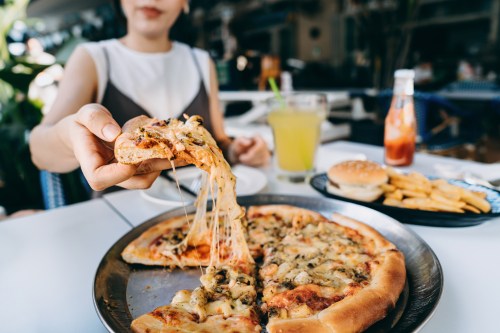Among the full range of essential minerals, manganese tends to fly under the radar. And that’s understandable, considering it’s a trace mineral—meaning you need less of it overall, compared to major minerals like calcium or phosphorous. That said, the benefits of manganese span a whole host of bodily functions, and it isn’t produced naturally by the body, so you do need to get your full allowance of it from your diet.
Experts in This Article
registered dietitian nutritionist and owner of Amy Gorin Nutrition
triple board-certified functional medicine nutritionist based in New York City
Natalie Olsen, RDN, LD, ACSM-EP is a registered dietitian nutritionist and exercise physiologist. Natalie currently does medical reviews for Healthline Media, Greatist and Medical News Today, as well as the Simple Intermittent Fasting App. She is also a corporate wellness dietitian for Crossover Health at the Apple, Inc. campus in Austin, Texas.
“I think manganese is quite underrated,’’ says registered dietitian Natalie Olsen, RDN, LD, ACSM-EP. “It’s required for the metabolic processes involving amino acids, glucose, cholesterol, and the breakdown of carbohydrates.” Not to mention, it’s a cofactor for several enzymes (aka a helper molecule that allows the enzymes to function properly), including those required for the mineralization of bone, says nutritionist and functional-medicine practitioner Dana James, MS, CNS, CDN: “As a result, it’s just as important for bone density as calcium and magnesium.”
Given that you don’t need a ton of manganese to reap its benefits, however, it’s very possible to consume enough of it through food alone (and without risk of getting too much of it), says plant-based registered dietitian Amy Gorin, MS, RDN, owner of Plant-Based Eats in Stamford, CT. She adds that many multivitamins contain manganese, too, but the experts agree that dietary sources (more on those below) are the most efficient way to get your daily dose.
Here, Olsen, James, and Gorin share what you need to know about the benefits of manganese and where to find it.
What is manganese?
To recap, manganese is a trace mineral that’s essential for several body processes relating to bone health, blood health, and immunity. While everyone requires manganese to keep these body functions in check, there are also a few preliminary studies suggesting that additional manganese supplementation may improve glucose tolerance in those with diabetes.
Another group that should be particularly aware of manganese consumption is pregnant people, as a study published last month in Environmental Health Perspectives showed that children exposed to higher levels of both manganese and seleniumin utero had a lower risk of high blood pressure during childhood.
What are the benefits of manganese?
It supports bone health.
Consider this manganese’s starring role, as there’s more evidence to support manganese’s role in bone density than perhaps in any other area. As noted above, we know that manganese plays a key part in the enzyme process that allows for bone formation, including the synthesis of cartilage and bone collagen, as well as bone mineralization. As further proof, consider the 2009 study showing that those with osteoporosis have lower levels of manganese in their blood than those with normal, healthy bone density.
It helps fight inflammation.
Similar to how manganese aids in the formation of bone as an enzyme cofactor, it also allows for the creation of the antioxidant superoxide dismutase. Antioxidants, as a refresher, work to break down free radicals, lowering overall levels of inflammation in the body.
It boosts blood quality.
Manganese also works alongside vitamin K to support healthy blood clotting, meaning that having sufficient levels can help speed up the wound-healing process and keep you from losing ample blood with a serious injury.
How much manganese do I need?
The daily value for manganese is 2.3 milligrams, says Gorin. (Though pregnant and breastfeeding people may need up to 2.6 mg daily.)
It’s also worth noting that higher levels of iron may lead to lower absorption of manganese, says Olsen, so ensuring that you’re staying within the recommended window for iron consumption will help balance manganese levels in the body, too.
It’s very unlikely that you’ll go overboard or experience any issues as a result of excessive manganese exposure, says Gorin. Rather than with dietary intake, that typically only happens with inhaling manganese dust, particularly in the welding and mining industries, or drinking well water that’s very high in manganese. In these extremely rare cases, toxicity can result in tremors, insomnia, and hearing impediment, among other symptoms—but again, dietary over-consumption is highly uncommon.
By contrast, manganese deficiency may lead to bone-health issues, such as poor growth in children, as well as bone demineralization, skin rashes, and hair depigmentation, though it’s worth noting that the evidence in this realm is slim, as there’s not a great clinical measurement of manganese, adds Olsen.
What are the best sources of manganese?
1. Shellfish including mussels, oysters, and clams
Mussels are a grand slam when it comes to manganese, packing 5.8 mg per 3 ounces, says Olsen. Oysters and clams each pack about 1 mg per 3-ounce serving.
2. Whole grains like brown rice and oatmeal
There are tons of good reasons to fill your diet with whole grains, but you can now add manganese intake to that list: Brown rice, for example, has 1.1 mg of manganese in every ½ cup. Consider the classic rice-and-beans combo for a well-rounded (and longevity-boosting) dish. Oatmeal also has 0.7 mg per ½ cup serving.
3. Hazelnuts, pecans, and peanuts
Many kinds of nuts are rich in protein and healthy fats—and in some cases, manganese, too. Hazelnuts have 1.6 mg per 1-ounce serving, while pecans have 1.1 mg, and peanuts have 0.5 mg for the same-sized serving.
4. Spinach
Dark-green vegetables are basically the food that can do no wrong, and in the case of spinach, in addition to its hefty dose of fiber and antioxidants, it also packs 0.8 mg of manganese in every ½ cup (with the measurement taken for a ½ cup of the boiled green, that is). Not a fan of the taste? Up your intake with this spinach-rich pesto, which is also loaded with fragrant garlic and rosemary.
5. Pineapple
Summer’s quintessential fruit (hello, piña colada) can boost gut health and immunity—and also contains 0.8 mg of manganese per ½ cup.
6. Chickpeas
A ½-cup of chickpeas has 0.9 mg of manganese, making it a solid option to getting you almost halfway to your daily allowance. Not to mention, chickpeas are also loaded with fiber and can help keep blood-sugar and energy levels even-keeled. It’s easy to toss them into a salad or pasta dish, but you could also try pickling or roasting chickpeas to amp their flavor even more.
Oh hi! You look like someone who loves free workouts, discounts for cult-fave wellness brands, and exclusive Well+Good content. Sign up for Well+, our online community of wellness insiders, and unlock your rewards instantly.
Sign Up for Our Daily Newsletter
Get all the latest in wellness, trends, food, fitness, beauty, and more delivered right to your inbox.
Got it, you've been added to our email list.










